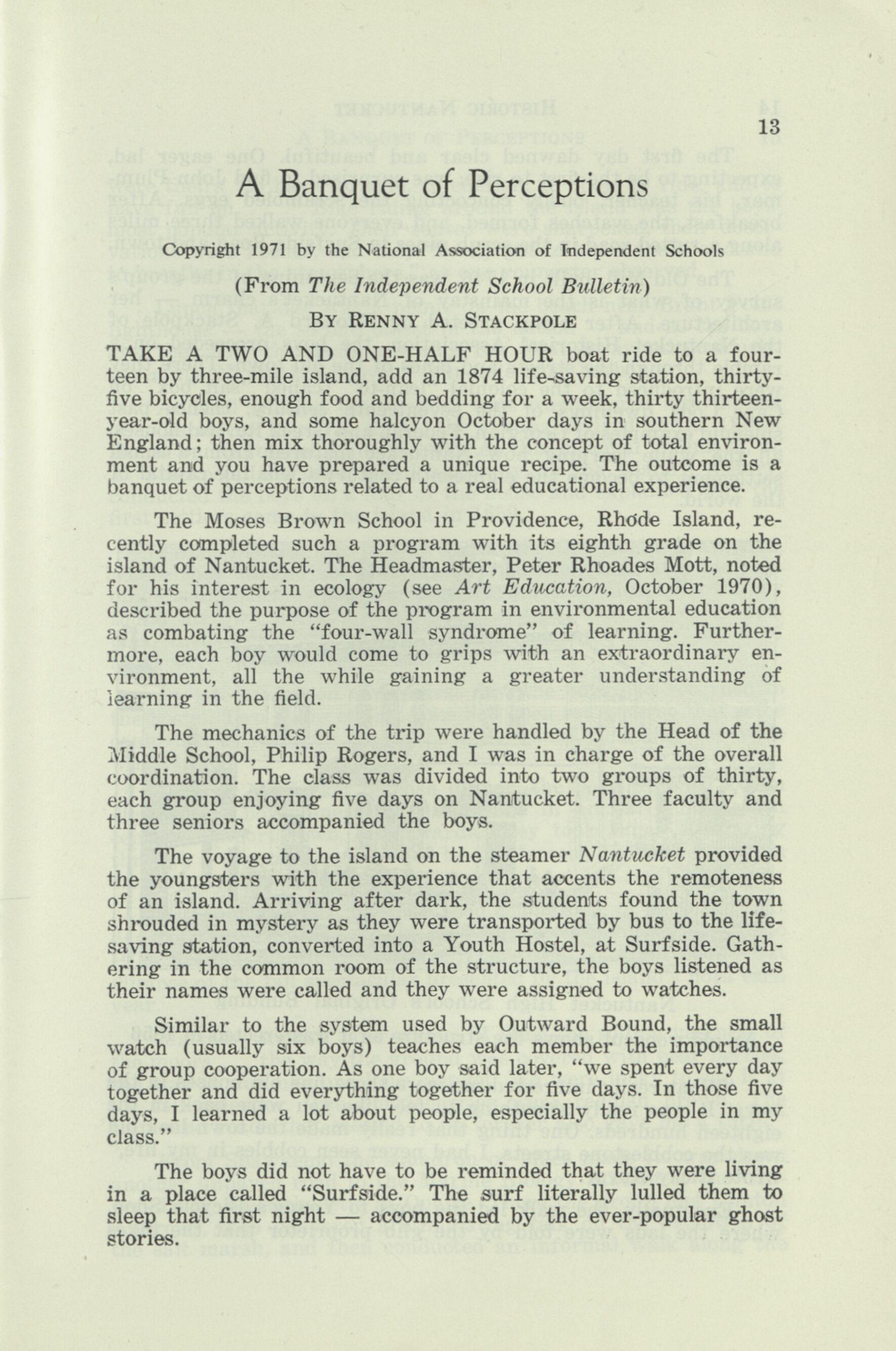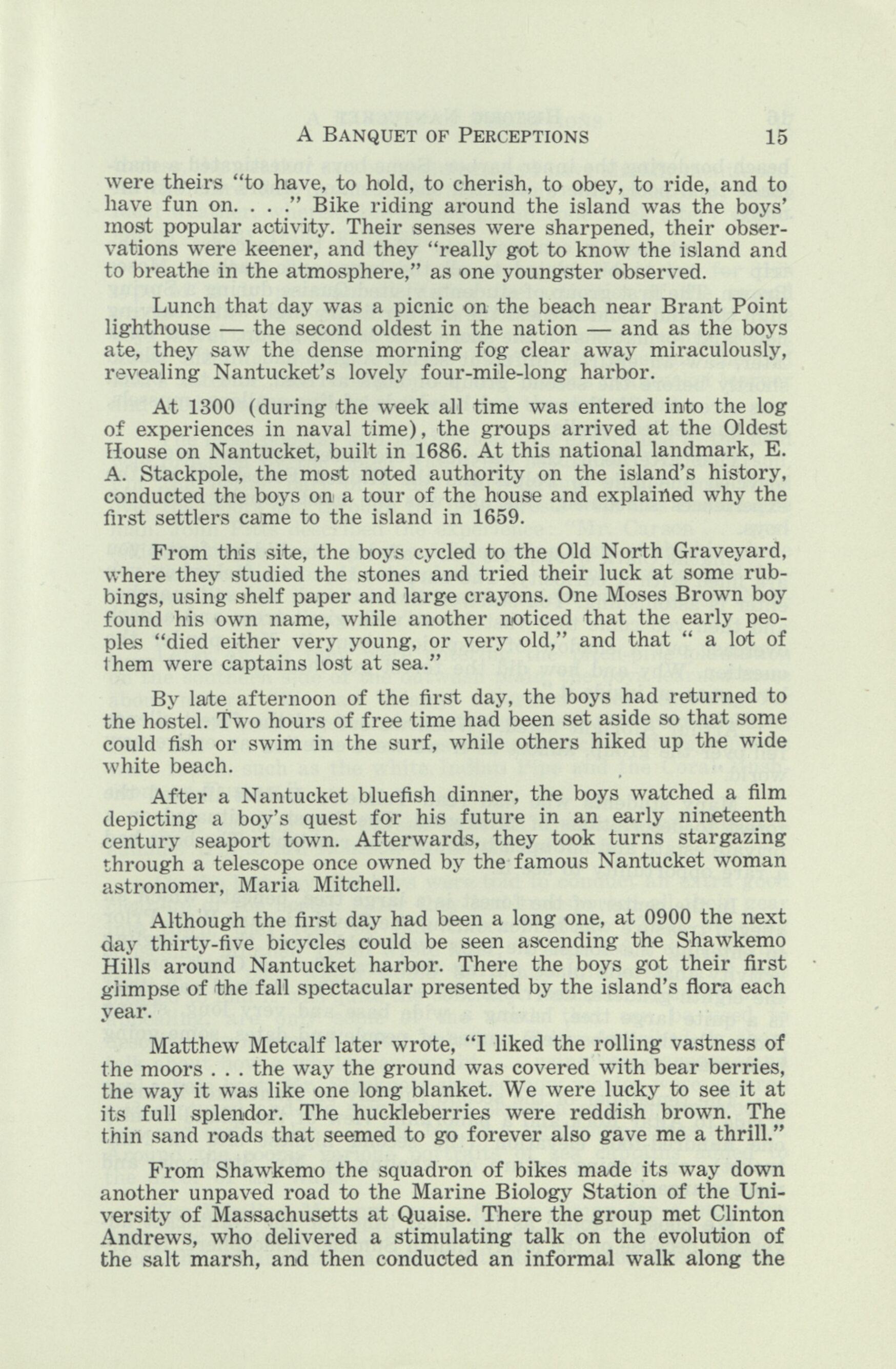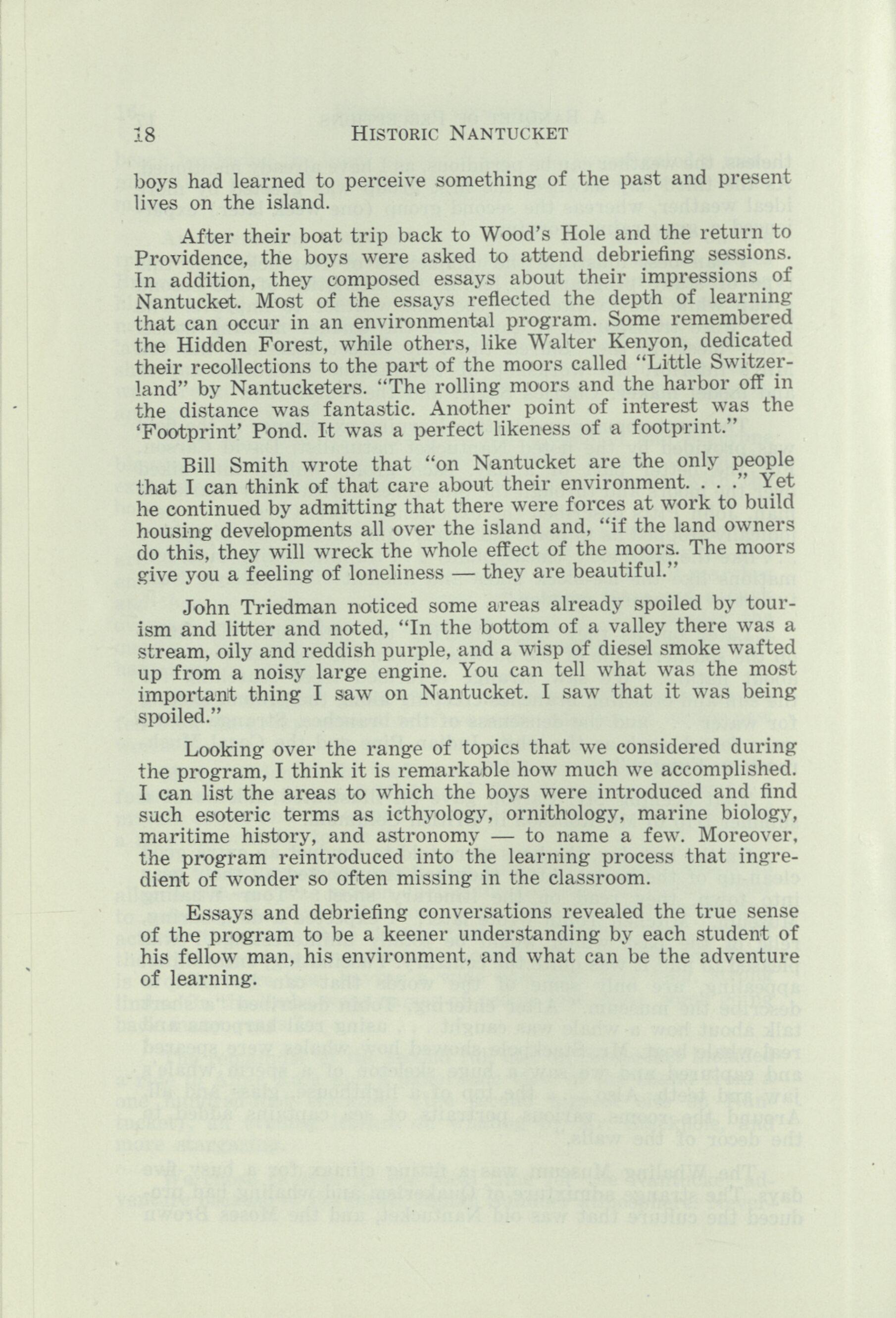
11 minute read
A Banquet of Perceptions
13
Copyright 1971 by the National Association of Independent Schools
(From The Independent School Bulletin)
BY RENNY A. STACKPOLE
TAKE A TWO AND ONE-HALF HOUR boat ride to a fourteen by three-mile island, add an 1874 life-saving station, thirtyfive bicycles, enough food and bedding for a week, thirty thirteenyear-old boys, and some halcyon October days in southern New England; then mix thoroughly with the concept of total environment and you have prepared a unique recipe. The outcome is a banquet of perceptions related to a real educational experience.
The Moses Brown School in Providence, Rhode Island, recently completed such a program with its eighth grade on the island of Nantucket. The Headmaster, Peter Rhoades Mott, noted for his interest in ecology (see Art Education, October 1970), described the purpose of the program in environmental education as combating the "four-wall syndrome" of learning. Furthermore, each boy would come to grips with an extraordinary environment, all the while gaining a greater understanding of learning in the field.
The mechanics of the trip were handled by the Head of the Middle School, Philip Rogers, and I was in charge of the overall coordination. The class was divided into two groups of thirty, each group enjoying five days on Nantucket. Three faculty and three seniors accompanied the boys.
The voyage to the island on the steamer Nantucket provided the youngsters with the experience that accents the remoteness of an island. Arriving after dark, the students found the town shrouded in mystery as they were transported by bus to the lifesaving station, converted into a Youth Hostel, at Surfside. Gathering in the common room of the structure, the boys listened as their names were called and they were assigned to watches.
Similar to the system used by Outward Bound, the small watch (usually six boys) teaches each member the importance of group cooperation. As one boy said later, "we spent every day together and did everything together for five days. In those five days, I learned a lot about people, especially the people in my class."
The boys did not have to be reminded that they were living in a place called "Surfside." The surf literally lulled them to sleep that first night — accompanied by the ever-popular ghost stories.
14
HISTORIC NANTUCKET
The first day dawned clear and beautiful. One eager lad, expecting to be the first to rise, was surprised to find John Plummar, his teacher, busily concocting the scrambled eggs. After breakfast, the watches formed, and everyone walked three miles along a rutted road in the scrub pines to Surfside Road and town.
The Old Mill, built in 1746, was the beginning of the group's survey of what is the mainstay of Nantucket's charm — her architecture. After being greeted by Edouard A. Stackpole of the Nantucket Historical Association, the boys proceeded on a ramble through the streets and lanes of the old town. There they were introduced to the colonial "lean-to" (called "salt box" on Cape Cod) dwellings of the seventeenth century, thence past splendid examples of Georgian, Federal, and Greek Revival houses, all the while learning how Nantucket matured from a small settlement to become the eighteenth century's whaling capital of the world.
Nantucket High School's Original Building An old woodcut shows the structure as it was erected in 1856

"What really interested me were those fine old houses in the town. It was really something to feel like you were back in the eighteen hundreds. One thing that really made the town look old was the cobblestone streets. I had never seen cobbles in my life," wrote Ricky Kovar.
Eventually, the walk led the boys to Young's Bicycle Shop, where the lads were told by the glib proprietor that the bikes
A BANQUET OF PERCEPTIONS 15
were theirs "to have, to hold, to cherish, to obey, to ride, and to have fun on. . . Bike riding around the island was the boys' most popular activity. Their senses were sharpened, their observations were keener, and they "really got to know the island and to breathe in the atmosphere," as one youngster observed.
Lunch that day was a picnic on the beach near Brant Point lighthouse — the second oldest in the nation — and as the boys ate, they saw the dense morning fog clear away miraculously, revealing Nantucket's lovely four-mile-long harbor.
At 1300 (during the week all time was entered into the log of experiences in naval time), the groups arrived at the Oldest House on Nantucket, built in 1686. At this national landmark, E. A. Stackpole, the most noted authority on the island's history, conducted the boys on a tour of the house and explained why the first settlers came to the island in 1659.
From this site, the boys cycled to the Old North Graveyard, where they studied the stones and tried their luck at some rubbings, using shelf paper and large crayons. One Moses Brown boy found his own name, while another noticed that the early peoples "died either very young, or very old," and that " a lot of them were captains lost at sea."
By late afternoon of the first day, the boys had returned to the hostel. Two hours of free time had been set aside so that some could fish or swim in the surf, while others hiked up the wide white beach.
After a Nantucket bluefish dinner, the boys watched a film depicting a boy's quest for his future in an early nineteenth century seaport town. Afterwards, they took turns stargazing through a telescope once owned by the famous Nantucket woman astronomer, Maria Mitchell.
Although the first day had been a long one, at 0900 the next day thirty-five bicycles could be seen ascending the Shawkemo Hills around Nantucket harbor. There the boys got their first glimpse of the fall spectacular presented by the island's flora each year.
Matthew Metcalf later wrote, "I liked the rolling vastness of the moors . . . the way the ground was covered with bear berries, the way it was like one long blanket. We were lucky to see it at its full splendor. The huckleberries were reddish brown. The thin sand roads that seemed to go forever also gave me a thrill."
From Shawkemo the squadron of bikes made its way down another unpaved road to the Marine Biology Station of the University of Massachusetts at Quaise. There the group met Clinton Andrews, who delivered a stimulating talk on the evolution of the salt marsh, and then conducted an informal walk along the

16
HISTORIC NANTUCKET
beach bordering' the inner harbor. Some boys investigated a manmade tidal pool; others collected shells; many others went swimming.
An interesting contrast was afforded the teachers on the trip — one to be related to all the boys, once back at Moses Brown. The first group of students visited Quaise during a Spring high tide and could witness the extraordinary high water carving new land formations on the shore. The second group, just a week later, saw an entirely different scene. A gale had hit the island shortly before the second group of boys arrived, and the beach was strewn with flotsam and hundreds of live scallops, mussels, and quarterdeck shells.
That afternoon, the watches were assembled and everyone bicycled one mile to Polpis and the Hidden Forest. Of all the experiences scheduled, this one was the most popular with the boys.
Charlie Clark wrote, "As you walk into the hidden forest you are filled with a curiosity. The surprise that you feel when you enter is astonishing. You start off in low brush and salt marshes and then you come to a vast forest with giant trees and a dark overcast put a shadow of suspicion about it. You ponder the question, Why and how did the forest get there and what must have gone on inside it."
Arthur Albright noted, "When we entered the forest silence fell over the group, almost as if we were entering an entire new world."
Many students who had read Tolkien's Hobbit likened the forest to descriptions of Mirkwood. The forest is situated on a private estate and not open to tourists or residents. The boys had a rare opportunity to see it.
In the center of the forest is a large tree, beneath which an alleged treasure was hidden during the Revolutionary War. Prior to entering the forest the boys were told about the smuggling activity that took place during that era. Charles Clark, one of the eighth-graders, described the scene: "The chained oak itself is a quite large tree, having a wide base and very long, strong limbs. On the limbs were names of people and dates, some going back many years."
The remainder of the second full day on Nantucket included a ride to Altar Rock and a panoramic view of the island from a one hundred-foot elevation (the second highest site on Nantucket), an evening lecture on whaling by Mr. Stackpole, and more stargazing.
We chose October as the ideal time for the Nantucket adventure because of the lovely Indian Summer atmosphere. Never-

A BANQUET OF PERCEPTIONS
17
theless, the weather can be perfidious, as I have already mentioned. As the third day dawned, the first group was greeted by more ideal weather, whereas the second group (one week later) experienced a gray rainy morning. I can best illustrate the uniqueness of Nantucket for this type of study program by listing the activities of the second group while they waited for the foul weather to improve. The boys were transported to town and the Quaker meeting house. After meeting, they toured the Fair Street Museum, the Old Mill's interior, the workshop of the famous Nantucket carver and model maker, Charles Sayle, and the waterfront.
The most popular and lasting learning experience in the field was provided by the noted Nantucket naturalist, David Carson. For the better part of a day, each group walked and biked over the moors and through the pine forests with this remarkable man. John Pitts described the experience: "Mr. Carson . . . periodically stopped us to point out interesting facts of the biosphere . . . like the bearberry (mealyplum) . . . the interesting land formations like the ice-block lakes and ancient river valleys. Nantucket is a natural wonder."
Later on, as they were entering the pitch-pine plantation on the southern side of the outwash plain, the boys learned more about nature. "We saw strange deformed trees searching for the sun and crawling branches creeping along the ground looking for water . . . and the denseness of the branches. Strange plants were found, such as the white Indian Pipe and the Coral Mushroom or Fungus."
That evening Mr. Carson gave an illustrated talk about a summer trip to Mt. Robeson in British Columbia.
On the last day, the boys were told to conduct an extra good clean-up of the hostel. After they had transported all their gear into town, they read on the itinerary sheet: "Tour Whaling Museum." Mitchell Tobin wrote later, "I expected a dull, boring, relic of the past which would be totally uninteresting. I was pleased to find it was quite the contrary. Fascinating, enthralling, appealing, are only some of the words that can be used to describe the museum." After entering, Tobin described "a short talk about how a whale was caught . . . using real harpoons and real whale boat. Mr. Stackpole showed how whales were speared and captured and we saw a huge skeleton of a sperm whale's jaw and teeth. Also . . . the top of a lighthouse, glass and all. Around the rooms various portraits of sea captains added to the decor of the walls."
The Whaling Museum was a fitting climax for a busy five days. The strange admixture of Quakerism and whaling had produced the culture that was old Nantucket, and the Moses Brown

18
HISTORIC NANTUCKET
boys had learned to perceive something of the past and present lives on the island.
After their boat trip back to Wood's Hole and the return to Providence, the boys were asked to attend debriefing sessions. In addition, they composed essays about their impressions _ of Nantucket. Most of the essays reflected the depth of learning that can occur in an environmental program. Some remembered the Hidden Forest, while others, like Walter Kenyon, dedicated their recollections to the part of the moors called "Little Switzerland" by Nantucketers. "The rolling moors and the harbor off in the distance was fantastic. Another point of interest was the 'Footprint' Pond. It was a perfect likeness of a footprint."
Bill Smith wrote that "on Nantucket are the only people that I can think of that care about their environment. . . ." Yet he continued by admitting that there were forces at work to build housing developments all over the island and, "if the land owners do this, they will wreck the whole effect of the moors. The moors give you a feeling of loneliness — they are beautiful.
John Triedman noticed some areas already spoiled by tourism and litter and noted, "In the bottom of a valley there was a stream, oily and reddish purple, and a wisp of diesel smoke wafted up from a noisy large engine. You can tell what was the most important thing I saw on Nantucket. I saw that it was being spoiled."
Looking over the range of topics that we considered during the program, I think it is remarkable how much we accomplished. I can list the areas to which the boys were introduced and find such esoteric terms as icthyology, ornithology, marine biology, maritime history, and astronomy — to name a few. Moreover, the program reintroduced into the learning process that ingredient of wonder so often missing in the classroom.
Essays and debriefing conversations revealed the true sense of the program to be a keener understanding by each student of his fellow man, his environment, and what can be the adventure of learning.









